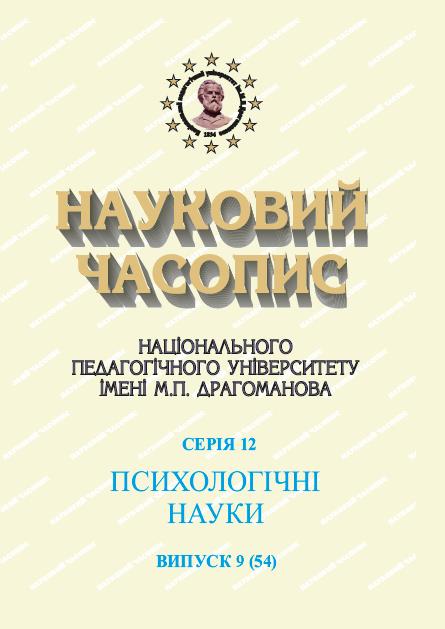ACTIVATION OF STUDENTS’ CREATIVE POTENTIAL IN THE PROFESSIONAL TRAINING PROCESS
DOI:
https://doi.org/10.31392/NPU-nc.series12.2020.9(54).09Keywords:
creativity, creative potential, activation, development, students, fairy tales, training.Abstract
The article is devoted to the study of the creative potential of the student in the process of his professional preparation in the institution of higher education. Theoretical analysis of the psychological and pedagogical literature was carried out, the educational activities with the students of the specialty of preschool education were analyzed, the systematic observation of the students’ creative potential during practical classes and in the process of conducting creative competitions, cultural mass and educational events was carried out.
Scientists have shown that creative potential is an integrating quality of a person, which characterizes the extent of his ability to set and solve new tasks in the sphere of his activity, which is of social importance. It has been found that the sphere of creative potential includes: makings, inclinations, interests (dominance of cognitive interests); inquisitiveness (tendency to seek solutions); speed in assimilation of new information; ability to create standards for further selection; expressions of general intelligence; emotional attitude to events, etc. The own definition of professional training of future specialists is given, namely: professional training is not only the acquisition of a certain qualification in the relevant area, but also a means of socialization of the modern student, its harmonization with the real reality, acquiring him basic knowledge in a certain field and qualities of professional culture, development his creative abilities.
The diagnostic study was based on three main components and criteria for them: cognitive component (awareness of one’s own creative abilities), speech component (verbal creativity); activity component (constructive activity, originality of the created image). Diagnostic results testify to the insufficient level of students’ creative potential, especially in terms of speech and activity components. In order to activate the creative potential of students – future educators of preschool education and practical psychologists, we have developed a psychological program that contains a system of practical classes and educational activities, among which the fairy tales are presented in more detail.
References
- Davydov, V.V. & Leont'ev, D.A. (Ed.). (1990). Dejatel'nostnyj podhod v psihologii: problemy i perspektivy : Sb. nauchn. tr. [An Active Approach in Psychology: Problems and Prospects: A Collection of Scientific Papers]. Moscow : APN SSSR [in Russian].
- Moliako, V.O., MuzykaL. (Ed.). (2006). Zdibnosti, tvorchist, obdarovanist : teoriia, metodyka, rezultaty doslidzhen [Abilities, creativity, giftedness: theory, methodology, research results]. Zhytomyr : Vyd-vo Ruta [in Ukrainian].
- Nychkalo, N.H. (2001). Neperervna profesiina osvita yak filosofska ta pedahohichna katehoriia [Continuing professional education as a philosophical and pedagogical category]. Neperervna profesiina osvita: teoriia i praktyka. – Continuing Professional Education: Theory and Practice, 1(2), 9-22 [in Ukrainian].
- Sokhan, L.V. & Yermakov, I.H. (1997). Mystetstvo zhyttietvorchosti osobystosti [Tekst] : nauk.-metod. posib. [The Art of Creating a Personality [Text]: a scientific and methodological manual]. Kyiv : IZMN [in Ukrainian].
- Turynina, O.L. (2007). Psykholohiia tvorchosti : Navch. posib. [Creativity Psychology: A Textbook].Kyiv : MAUP [in Ukrainian].
- Gillam, (2018). Creativity, Wellbeing and Mental Health Practice (Palgrave Studies in Creativity and Culture). Palgrave Studies in Creativity and Culture. Palgrave Pivot, Cham. https://doi.org/10.1007/978-3-319-74884-9
- Gough,G. (1992). Assessment of Creative Potential in Psychology and the Development of a Creative Temperament Scale for the CPI. In: Rosen J.C., McReynolds P. (eds) Advances in Psychological Assessment. Advances in Psychological Assessment, vol 8. Springer, Boston, MA. https://doi.org/10.1007/978-1-4757-9101-3_8
- Howe,J.A. (1999). Some influences on abilities. In: The Psychology of High Abilities. Palgrave, London. https://doi.org/10.1007/978-1-349-27647-9
- Makel,C. & Plucker, J.A. (2008) Creativity. In: Pfeiffer S.I. (eds) Handbook of Giftedness in Children. Springer, Boston, MA https:// doi.org/10.1007/978-0-387-74401-8_13
- Matusov, & Marjanovic-Shane, A. (2016). Dialogic Authorial Approach to Creativity in Education: Transforming a Deadly Homework into a Creative Activity. In: Glăveanu V. (eds) The Palgrave Handbook of Creativity and Culture Research. Palgrave Studies in Creativity and Culture. Palgrave Macmillan, London. https://doi.org/10.1057/978-1-137-46344-9_15

